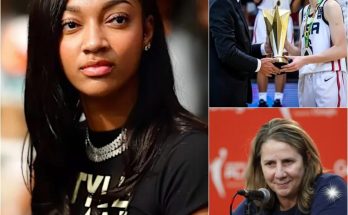
On a humid night in Indianapolis, the roar of the crowd was suddenly pierced by a collective gasp. Caitlin Clark—the rookie sensation who has electrified the WNBA and filled arenas like never before—was sprawled on the hardwood, the victim of yet another punishing foul. Cameras zoomed in as she grimaced and struggled to rise. But while Clark’s resilience has become almost legendary, it was what happened next that truly set the league ablaze.
Sophie Cunningham, a Phoenix Mercury guard known for her grit and candor, had seen enough. In a moment that would ricochet across social media and sports talk shows, Cunningham didn’t just defend her fellow player—she called out the league itself, accusing veteran stars of bullying tactics and blasting WNBA leadership for their silence. Her words weren’t the usual postgame platitudes. They were a declaration of war on the league’s old guard, its unwritten codes, and the favoritism that she says threatens the future of women’s basketball.
A Rookie’s Welcome or a Target on Her Back?
Caitlin Clark’s arrival in the WNBA was supposed to be a celebration—a new era, a fresh face, a surge of fan interest and media attention. The Iowa phenom broke college records and shattered ratings, and her pro debut brought sellout crowds to cities that hadn’t seen them in years. But for every highlight-reel three-pointer and dazzling assist, there’s been a darker undercurrent: hard fouls, elbows off the ball, and a growing sense that some veterans are determined to “teach her a lesson.”

Fans have noticed. Commentators have noticed. And so, too, has Sophie Cunningham.
“She’s not just getting a tough welcome,” Cunningham said after the game, her voice tight with emotion. “She’s being targeted, plain and simple. And the league is letting it happen.”
The Tipping Point
The play that sparked Cunningham’s outburst was brutal even by playoff standards. Clark, racing around a screen, was blindsided by a forearm to the chest and crashed to the floor. The refs called a common foul. The crowd booed. Clark, as always, got up and kept playing.
But Cunningham saw more than just a physical play—she saw a pattern. “We talk about growing the game, about protecting our stars,” she said. “But what message are we sending when the biggest new talent in the league can’t get a fair whistle? When she’s getting knocked down every night and nobody says a word?”
A League Divided
Cunningham’s comments struck a nerve. Within hours, her words were trending on X (formerly Twitter), with fans and analysts picking sides. Some saw her as a truth-teller, exposing the league’s hypocrisy and double standards. Others accused her of stirring the pot, of disrespecting the veterans who built the WNBA’s foundation.
But behind the noise, a deeper question loomed: Is the league really protecting its future? Or is it stuck in old rivalries and resentments that threaten to drive away its brightest stars?
The Politics of Respect
For years, the WNBA has prided itself on being a sisterhood—a league where players support each other, fight for equality, and lift each other up. But Cunningham’s outburst exposed the cracks in that narrative. The truth is, the arrival of a phenom like Caitlin Clark has unsettled the old order.
Some veterans see her as a media creation, an unproven rookie who hasn’t paid her dues. Others resent the sudden attention and endorsement deals she commands. And still others, like Cunningham, worry that the league’s reluctance to protect its stars will drive away the very fans and sponsors it so desperately needs.
“We can’t have it both ways,” Cunningham said. “We can’t say we want to grow the game and then stand by while our biggest draw gets bullied out of it.”
The League’s Response—Or Lack Thereof
If Cunningham was hoping for a swift response from league officials, she was disappointed. The WNBA issued a brief statement about “player safety,” but made no mention of Clark or the specific incident. The referees’ union defended the call. And in locker rooms around the league, there was a tense silence.
But outside those walls, the debate raged on. On ESPN, analysts debated whether Clark was being hazed or simply learning the ropes. On social media, fans posted side-by-side videos of Clark’s fouls compared to those called on other players. The consensus? Something felt off.
A Battle for the Soul of the League
Cunningham’s comments weren’t just about one player—they were about the future of the WNBA itself. The league has never been more popular, never had more eyes on it. But with that attention comes pressure: to protect its stars, to foster new rivalries, and to ensure that the next generation of talent isn’t driven away by politics and favoritism.
“People tune in to see Caitlin Clark,” Cunningham said. “They want to see her play, not get knocked down. If we don’t protect that, we’re risking everything we’ve built.”
Clark’s Response: Grace Under Fire
For her part, Clark has handled the scrutiny with remarkable poise. She’s refused to criticize her opponents, instead focusing on her own growth and the team’s success. “It’s a physical league,” she said after the game. “I’m learning every day. I just want to play basketball.”
But as Cunningham pointed out, even the toughest rookies need support. “She shouldn’t have to fight this battle alone,” Cunningham said. “We all have a responsibility—to the game, to the fans, and to each other.”

What Happens Next?
The fallout from Cunningham’s comments is still unfolding. Will the league step up and enforce stricter rules on flagrant fouls? Will veteran players heed the call for respect and sportsmanship? Or will the politics of the past continue to overshadow the promise of the future?
One thing is clear: the WNBA is at a crossroads. The decisions made now will shape not just the fate of Caitlin Clark, but the direction of the league for years to come.
A Declaration of War—And a Call to Action
As the dust settles, Cunningham’s message rings louder than ever: Protect the talent, or lose the future of the league. It’s a line in the sand, a challenge to everyone who loves the game to stand up and demand better.
Because in the end, the story of Caitlin Clark isn’t just about one player. It’s about what kind of league the WNBA wants to be—and whether it’s brave enough to change.



